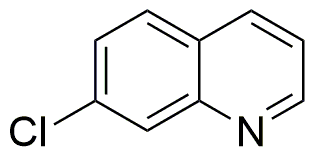7-Chloroquinoline is widely utilized in research focused on:
- Pharmaceutical Development: This compound serves as a key intermediate in the synthesis of various pharmaceuticals, particularly antimalarial and antibacterial agents, enhancing treatment options for infectious diseases.
- Material Science: It is used in the development of specialized coatings and polymers, providing improved chemical resistance and durability for industrial applications.
- Analytical Chemistry: 7-Chloroquinoline is employed as a reagent in analytical methods, aiding in the detection and quantification of metal ions in environmental samples.
- Fluorescent Probes: The compound is utilized in creating fluorescent probes for biological imaging, allowing researchers to visualize cellular processes with greater clarity.
- Research on Heterocyclic Compounds: It plays a significant role in studies aimed at understanding the properties and reactivity of heterocyclic compounds, contributing to the advancement of organic chemistry.
General Information
Properties
Safety and Regulations
Applications
7-Chloroquinoline is widely utilized in research focused on:
- Pharmaceutical Development: This compound serves as a key intermediate in the synthesis of various pharmaceuticals, particularly antimalarial and antibacterial agents, enhancing treatment options for infectious diseases.
- Material Science: It is used in the development of specialized coatings and polymers, providing improved chemical resistance and durability for industrial applications.
- Analytical Chemistry: 7-Chloroquinoline is employed as a reagent in analytical methods, aiding in the detection and quantification of metal ions in environmental samples.
- Fluorescent Probes: The compound is utilized in creating fluorescent probes for biological imaging, allowing researchers to visualize cellular processes with greater clarity.
- Research on Heterocyclic Compounds: It plays a significant role in studies aimed at understanding the properties and reactivity of heterocyclic compounds, contributing to the advancement of organic chemistry.
Documents
Safety Data Sheets (SDS)
The SDS provides comprehensive safety information on handling, storage, and disposal of the product.
Product Specification (PS)
The PS provides a comprehensive breakdown of the product’s properties, including chemical composition, physical state, purity, and storage requirements. It also details acceptable quality ranges and the product's intended applications.
Certificates of Analysis (COA)
Search for Certificates of Analysis (COA) by entering the products Lot Number. Lot and Batch Numbers can be found on a product’s label following the words ‘Lot’ or ‘Batch’.
*Catalog Number
*Lot Number
Certificates Of Origin (COO)
This COO confirms the country where the product was manufactured, and also details the materials and components used in it and whether it is derived from natural, synthetic, or other specific sources. This certificate may be required for customs, trade, and regulatory compliance.
*Catalog Number
*Lot Number
Safety Data Sheets (SDS)
The SDS provides comprehensive safety information on handling, storage, and disposal of the product.
DownloadProduct Specification (PS)
The PS provides a comprehensive breakdown of the product’s properties, including chemical composition, physical state, purity, and storage requirements. It also details acceptable quality ranges and the product's intended applications.
DownloadCertificates of Analysis (COA)
Search for Certificates of Analysis (COA) by entering the products Lot Number. Lot and Batch Numbers can be found on a product’s label following the words ‘Lot’ or ‘Batch’.
*Catalog Number
*Lot Number
Certificates Of Origin (COO)
This COO confirms the country where the product was manufactured, and also details the materials and components used in it and whether it is derived from natural, synthetic, or other specific sources. This certificate may be required for customs, trade, and regulatory compliance.


